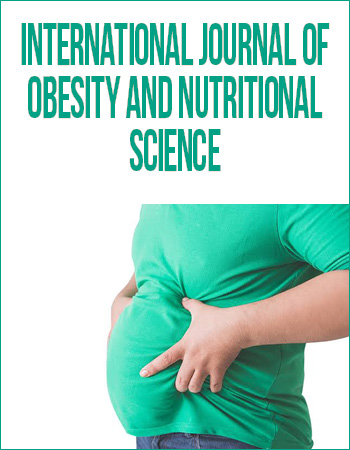Research Article
Effect of Beetroot Juice on Body Composition, Physical Function, Muscle Strength, and Peak Oxygen Consumption in Resistance Trained Older Adults Consuming a Protein Supplement
1Department of Health and Exercise Science, Wake Forest University, USA
2Translational Science Center, Wake Forest University, USA
*Corresponding author: Gary D. Miller, Department Health and Exercise Science, Wake Forest University, Box 7868 Reynolda Station, Winston-Salem, NC 27109-7868, USA, E-mail: millergd@wfu.edu
Received: July 27, 2022 Accepted: August 24, 2022 Published: September 05, 2022
Citation: Miller GD , Becton JT, Michel JM, Berry MJ. Effect of Beetroot Juice on Body Composition, Physical Function, Muscle Strength, and Peak Oxygen Consumption in Resistance Trained Older Adults Consuming a Protein Supplement. Int J Obes Nutr Sci. 2022; 3(1): 41-49. doi: 10.18689/ijons-1000107
Copyright: © 2022 The Author(s). This work is licensed under a Creative Commons Attribution 4.0 International License, which permits unrestricted use, distribution, and reproduction in any medium, provided the original work is properly cited.
Abstract
Introduction: Body composition changes with aging, including reduction in lean body mass leads to impaired physical function, decreased muscular strength and reduced peak oxygen consumption (VO2 peak), and notably, increased mortality and loss of independence. The present study compared the effects of a nitrate containing beetroot juice supplement (BRJ+Nitrate) vs. a placebo (Control) on total and regional body fat free mass, quadriceps muscle strength, lower body mobility, and VO2 peak in healthy, older adults undergoing a 10-week long progressive resistance training program with protein supplementation.
Methods: In this double-blind, placebo-controlled trial healthy men and women (n=24) were randomized into BRJ+Nitrate or Control group. Measurements obtained at baseline and 10-week follow-up included whole and regional body composition, lower limb muscular strength, 400 meter walk time, stair climb time, and VO2 peak.
Results: No between group differences were seen for outcomes as analyzed using a 2-way analysis of variance. Improvements were apparent over time when both groups were combined in muscle strength, stair climb time, 400 meter walk time, and VO2 peak, but not in total or regional body composition measures.
Conclusions: The use of a nitrate containing beetroot juice does not enhance the improvement of muscle strength, physical function, and VO2 peak observed in healthy older adults undergoing a resistance training program coupled with protein supplementation.
Keywords: Nitrate; Insulin Resistance; Mobility Disability Clinicaltrials.gov: NCT05460351
Introduction
Declines in lean body mass with aging leads to impaired physical function, decreased muscular strength and reduced peak oxygen consumption (VO2 peak), and notably, increased mortality and loss of independence [4, 32]. Thus, developing effective and safe interventions to prevent or delay the reduction in lean body mass in older adults is critical. In comparison to younger adults, older adults have lower rates of postprandial protein synthesis, and are less responsive to the effect of protein supplementation to acute protein synthesis [13]. This dampened response with protein supplementation is, at least in part, due to an impaired insulin-stimulated endothelial-dependent vasodilation [34]. Insulin sensitive tissues, such as skeletal muscle, experience an increase in blood flow when nitric oxide is present, but no such response is observed when insulin resistant. This is present even in non-diabetic older adults with normal glucose tolerance and muscle glucose metabolism [11]. Thus, insulin resistance decreases the nitric oxide mediated vasodilator effect, which consequently reduces blood flow and the delivery of nutrients to the tissue [35]. Typically, the insulin response generated after the consumption of either carbohydrates or amino acids facilitates nitric oxide dependent vasodilation and subsequently, tissue perfusion. Consequently, the increase in the transport of amino acids into body tissues stimulates the mTORC1 pathway and protein synthesis in the tissue [18, 35].
One mechanism to increase nitric oxide in tissues is through the nitrate-nitrite-nitric oxide pathway [20]. Plasma nitrate is derived from endogenous mechanisms (including the oxidation of nitric oxide by nitric oxide synthase) and from dietary consumption (especially nitrate rich vegetables including beets and beet root juice) [12]. Plasma nitrate is concentrated in salivary glands and secreted back into the oral cavity where bacteria in the oral cavity partially reduce salivary nitrate to nitrite [9]. After swallowing, nitrate and nitrite in the gastrointestinal tract are absorbed into the plasma. Plasma nitrite is then reduced to nitric oxide, preferentially under hypoxic and acidic conditions such as in anaerobically active muscle tissue [9].
In a recent study insulin and sodium nitroprusside were infused in healthy older adults to investigate muscle perfusion and amino acid availability in non-diabetic older adults [34]. This treatment enhanced skeletal muscle protein synthesis through increased muscle perfusion and amino acid delivery as compared to insulin only treatment. As an alternative to using an organic nitrate such as sodium nitroprusside, consuming beetroot juice, a dietary source high in inorganic nitrate, increases nitric oxide bioavailability through the nitrate-nitrite-nitric oxide pathway. Previous research showed beetroot juice reduces resting blood pressure, lowers VO2 levels during submaximal exercise, improves regional brain blood flow, and increases time to task failure during aerobic activities [17, 31].
Thus, the central supposition driving this work is that beetroot juice in combination with a protein supplement and resistance exercise training will improve muscle strength and physical function and increase skeletal muscle mass in older adults. The present study compared the effects of a nitrate containing beetroot juice supplement (BRJ+Nitrate) vs. a nitrate depleted beetroot juice placebo (Control) on fat free mass, quadriceps muscle strength, lower body mobility, and VO2 peak in healthy, older adults who consumed a protein supplement and participated in a 10-week long progressive resistance training program. This was of interest in that It was hypothesized that the BRJ+Nitrate intervention would result in a greater increase in lean body mass, quadriceps muscle strength, physical function, and VO2 peak following a 10-week resistance training program supplemented by protein in comparison to the Control intervention. The rationale for the addition of the protein supplement was based on the premise that the mechanism for the improvement in body composition, physical function, and muscle strength from the nitrate containing beetroot juice would be due to improved blood flow to the working tissues, principally skeletal muscle. The protein supplement was provided to enhance substrate delivery, i.e. amino acids, to the muscles for anabolic and recovery of the tissue.
Materials & Methods
Subjects
In this double-blind, placebo-controlled trial, individuals were randomized into one of two groups: nitrate containing beetroot juice (BRJ+Nitrate) or nitrate depleted beetroot juice (Control). The study was approved by the Institutional Review Board and all participants provided written informed consent prior to their participation. Community-dwelling, non-diabetic, non-resistance training, older (≥ 60 years) men and women (n=24) were recruited to participate in this study. Interested individuals completed an initial telephone screen which included the collection of age, current medications, basic medical exclusion criteria such as medical diagnoses, confirmation of menopause in women, physical activity assessment and willingness to participate in the 10-week training program and consume the beetroot juice and whey protein supplements. If they passed the initial phone screen, they were scheduled to report to the laboratory to undergo further baseline testing. Prior to collection of measures at the baseline laboratory visit, participants completed an informed consent and a Health Insurance Portability and Accountability Act (HIPAA) authorization form. Full inclusion/exclusion criteria are shown in Table 1. Eligibility testing at the initial laboratory visit included measurement of height, weight, fasting glucose (to rule out diabetes), taste test of the beetroot juice and protein supplement, and graded exercise test.
Individuals interested in participating (n=145) were initially screened for eligibility by telephone. Thirty subjects were deemed eligible and interested in the study, and they all completed baseline testing visit 1. Twenty-seven subjects completed testing at baseline visit 2 with a total of 24 individuals randomized into the two intervention groups (see CONSORT flow diagram, Figure 1). Exclusions following baseline testing at visits 1 and 2 included: scheduling conflicts (n=2), inability to complete all testing and training (n=2), injury outside of the study (n=1), and abnormal response to graded exercise treadmill test (n=1). Two subjects withdrew from the Control group during the study unrelated to the intervention: one for knee surgery and one for heart surgery. One person withdrew from the BRJ+Nitrate group after randomization due to lack of time. One adverse event (severe dehydration) occurred during the intervention session. A total of 21 subjects completed the 10 week follow-up visit (n=12 for BRJ+Nitrate and n=9 for Control).
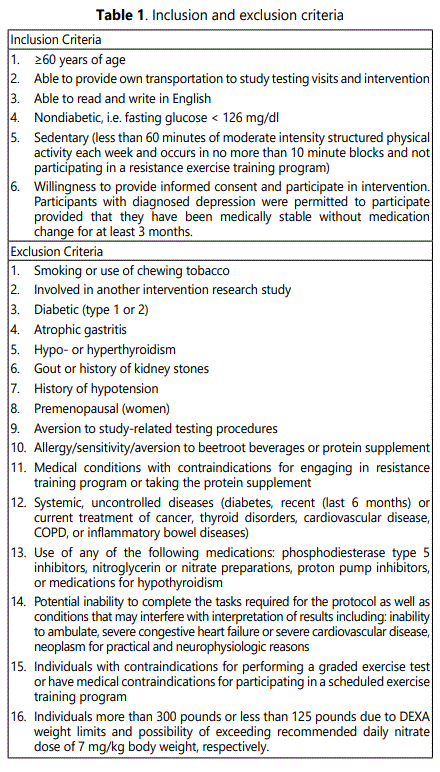
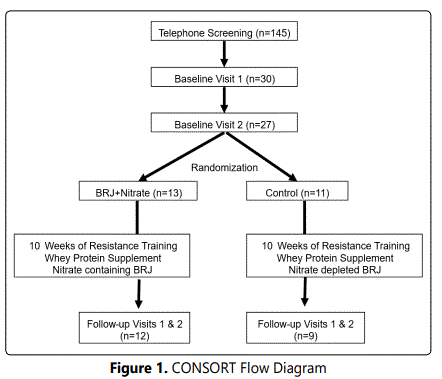
No significant differences were found among groups for baseline characteristics (Table 2). Across the cohort, mean age was about 67 years with 70% women and 90% white. Initial body mass index was approximately 28 kg/m2.
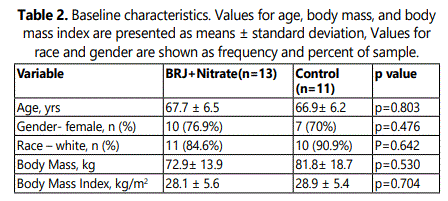
Testing and Measurements
Testing of the primary and secondary aims occurred prior to randomization at baseline and following the 10-week exercise and nutrition intervention. Testing took place on 2 separate days at each time point with the graded exercise test occurring on the first day and body composition and physical function tests measured on the second testing day.
Body weight and height: Using standard techniques, body weight and height were assessed to calculate body mass index.
Whole body and regional body composition: Whole body composition (fat mass and fat free mass) was acquired using total body dual energy x-ray absorptiometry (DXA) (GE Healthcare iDXA, General Electric Medical Systems Lunar, Madison, WI, USA) with the participant supine and aligned with the scanner table as prescribed by the manufacturer. Regional body composition (volumes of thigh muscle, thigh intermuscular fat, subcutaneous fat, and visceral fat) was assessed using computed tomography (CT) (LightSpeed PlusTM, General Electric Medical Systems, Milwaukee, WI, USA). For the abdominal region, the inner and outer aspects of the abdominal wall were manually traced. Visceral fat was defined as fat enclosed by the inner aspect of the abdominal wall and subcutaneous fat defined as the fat outside the outer aspects of the abdominal wall. For the thigh, intermuscular fat and visible intermuscular adipose tissue was separated from subcutaneous adipose by drawing a line along the deep fascial plane surrounding the mid-thigh muscles. The total volume of fat within the measured scans was used as a measure of fat volume (cm3) and the average value across both legs was used in data analyses. Total mid-thigh muscle volume was also assessed by CT (cm3).
Lower extremity muscle strength: Quadriceps muscle peak torque was measured using a Biodex System 4 Pro isokinetic dynamometer (Biodex Medical Systems, Shirley, NY, USA) at a speed of 60° per sec. Hips and knees were positioned at 90° of flexion and the input axis of the dynamometer was aligned with each the lateral epicondyle of the involved leg. Dynamometer position was recorded for each subject to match baseline and follow-up positions. Subjects were asked to extend the knee as hard as possible against the resistance pad, with a stop angle of 30° of flexion. The best performance of 3 trials was used for analyses.
400m walk: In this test, participants walked 10 laps in a corridor marked by cones on a 20 meters long indoor course. Participants were instructed to do their best and to walk at a fast pace; they were also given standardized encouragement during the testing. Performance was measured as time in minutes and seconds to the nearest 0.1 seconds.
Stair climb: The 12 Stair Climb was conducted on an indoor set of 12 stairs. Subjects were instructed to move as fast as they safely could and to give their best effort. The time to ascend and descend the 12 stairs was recorded to the nearest 0.01 seconds.
Graded exercise testing: A physician-supervised graded exercise test was performed using an individualized treadmill ramp protocol until volitional exhaustion. Subjects were then asked to select a brisk walking pace based on their own fitness and comfort level. Speed remained the same throughout the test. Grade was set at 0% for the first 2 min and was increased 1% every 30 seconds thereafter. Expired gas analysis was performed on a breath-by-breath basis during exercise using a Medical Graphics UltimaTM CardiO2® gas exchange analysis system (Medical Graphics Diagnostics Corporation, Saint Paul, MN, USA). All subjects received verbal encouragement throughout the test. This test was completed at baseline and 10-weeks follow-up to obtain peak oxygen update (VO2 peak).
Dietary intake: Daily food logs were used to assess dietary protein intake throughout the 10-week study. Protein content of foods was based on the American Diabetes Association food exchanges. Additionally, at each exercise visit, participants received a list of high nitrate containing foods to avoid and they designated on the form if they consumed any of these foods, and the amount and frequency consumed if they did.
Intervention Components
Resistance exercise training and supplementation: The resistance exercise training program was identical across both treatments and consisted of a center-based individualized, progressive resistance program. It was 3 days/week, 60 minutes/session with a goal of 3 sets of 8-12 repetitions on the main muscle groups for upper and lower body movements at 80% of predetermined maximal strength. Exercises performed on Nautilus® (Vancouver, Washington, USA) weight machines included: leg press, hip abduction, knee extension, knee flexion, seated row, vertical chest press, and incline chest press. Starting resistance for each session was determined from the one repetition maximum (RM) testing at the initial training visit. The intensity of the training was increased gradually over 2 weeks to reach the study goal. At week 1, intensity was 1 set at 10-12 repetitions of 50% of 1 RM. By the end of week 2, intensity was progressed to 2 sets at 8-12 repetitions of 70% of 1 RM. When participants were able to complete 3 sets of 12 repetitions at two consecutive training sessions, the resistance was increased to maintain progressive overload on the muscles. Study staff instructed participants on performing the exercises through the full range of motion in ~0.5 seconds for concentric contractions and 1-2 seconds for eccentric contractions. Records were kept for session attendance. Training volume (resistance, repetitions, and sets for each station) was documented.
Following each 60-minute resistance training session, participants were given one, 70 ml bottle of BEET IT Sport Shot (James White Drinks Ltd; Suffolk, United Kingdom) (with or without nitrate depending upon randomization) in addition to a 15 g serving of the whey protein supplement (GNC® Pro Performance 100% Whey Protein) with instructions to consume both within a 15-minute period at the training facility. The whey protein contained 15 g of leucine. The beetroot juice for both BRJ+Nitrate and Control was supplied in a 70 ml serving (Beet It Shot®, James White Drinks, Suffolk, United Kingdom). The placebo (Control) was indistinguishable in appearance and taste from the BRJ+Nitrate. As measured in our lab, the BRJ+Nitrate contained 380 mg (6.1 mmol) of nitrate per dose of supplement; the Control group consumed the same volume of juice supplement with the nitrate removed from the beverage by the manufacturer. Each shot contained 72 kcals with 2.5 g protein and 16 g of carbohydrates in a serving of the supplement. The BRJ+Nitrate and Control and protein supplements were provided and consumed at the exercise facility to facilitate compliance to the intervention. Furthermore, participants were instructed to avoid high nitrate sources in their diet (see section below).
Diet: Participants were given a list of high nitrates containing foods and told to limit/avoid these during the days when the supplement is consumed. All participants were requested to maintain a protein intake of 1.0 g/kg of body weight. This is a level that at a minimum provides the Dietary Reference Intakes of 0.8 g/kg body weight; research has also shown that this intake results in a net balance of zero in fat free mass in older adults undergoing a resistance training program [7]. All participants were counseled on their habitual diet consumption to meet the study goals. Each participant had an individualized daily protein intake goal and were provided with instructions and sample diets using food group exchange lists on how to meet this goal. Participants kept a food record and used food group exchanges to and calculate daily protein intake. These were reviewed weekly by the interventionists and participants were provided with suggestions for dietary manipulations on how to achieve their protein goal. The protein content of the whey and beetroot juice supplements was included in the daily protein goal.
Data analysis: Differences in baseline characteristics and compliance data between groups were analyzed using independent t-tests and data are reported as means ± standard deviation; race and gender were analyzed using chi-square tests. A 2-way analysis of variance (ANOVA) was used - with group as the between factor and time as the within factor - to test for differences in primary and secondary outcomes, as well as in weekly workloads. Results from this analysis are reported as estimated marginal means ± standard error of the mean. Statistical significance was accepted at p < 0.05. All analyses were performed using SPSS® version 28.0 (Chicago, IL).
Results
Adherence to exercise intervention and supplement use: When examining compliance to the intervention, no significant difference was found between BRJ+Nitrate and Control in the number of exercise sessions attended (~95% for both groups; 28.3 ± 0.7 vs 28.7 ± 0.5 sessions, respectively out of 30 possible sessions). The range for attendance was 21 to 30 sessions for completers, with 17 individuals attending at least 29 of the 30 sessions. Additionally, all participants consumed both the protein supplement and their respective beetroot juice at every exercise session attended.
Knee extensor strength and physical function: Results for knee extensor strength and physical function assessments are shown in Table 3. No group*time interactions and no group differences over the intervention period were observed in any of these measures. However, when groups were combined to study the effect of the strength training intervention in conjunction with the protein supplement over time, knee extensor strength increased from baseline to follow-up (Time means: 107.0 ± 9.0 (Baseline) vs 115.0 ± 10.5 (10-Week) Nm; p=0.022). Similarly, when groups were combined time to climb the stairs was statistically significantly faster at follow-up compared to baseline (Time means: 4.7 ± 0.3 (Baseline) vs. 4.4 ± 0.3 (10-Week) secs; p=0.050). There was a trend (p=0.083) for the time to complete the 400-meter walk to be lower (faster walking pace) at follow-up (Time means: 4.4 ± 0.2 minutes) than baseline (Time means: 4.6 ± 0.2 minutes).
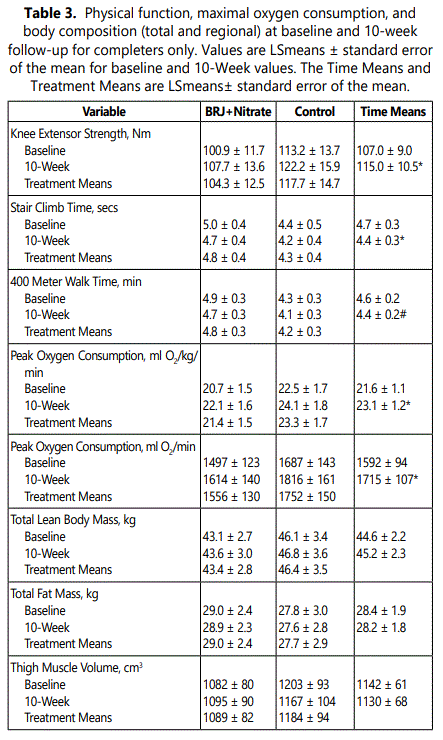
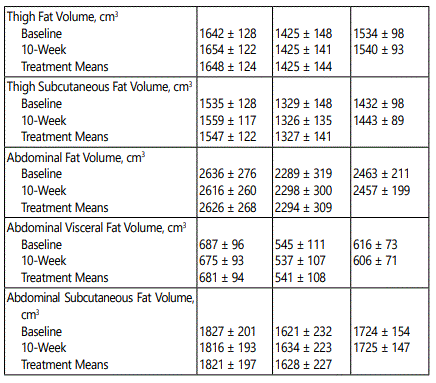
VO2peak: There were no group*time interactions and no group differences over the intervention period for VO2 peak expressed in relative or absolute terms (Table 3). However, when collapsed across groups VO2 peak (expressed both as ml O2/kg body weight/min and ml O2/min) showed significant increases of 7-8%, indicating improvement in cardiovascular fitness for the cohort.
Total and regional body composition: There was no statistically significant group* time interactions and no group or time main effects for any body composition assessments (Table 3). This includes total body fat free mass and fat mass (as measured by DXA) and regional fat free mass and fat mass (as measured by CT images).
Discussion
This study tested the hypothesis the BRJ+Nitrate intervention would result in a greater increase in fat free mass, quadriceps muscle strength, physical function, and VO2 peak following a 10-week resistance training program supplemented by protein in comparison to the Control intervention. The underlying mechanism for this hypothesis was that the insulin-resistance that occurs with aging, even in the presence of normal glucose homeostasis, dampens post-prandial protein synthesis, and that dietary nitrate would enhance nitric oxide dependent vasodilation and improve nutrient delivery to the muscles to increase resistance training benefits on physical function, body composition, and cardio-respiratory fitness in older adults. The results from the study do not support our hypothesis as there were no group differences in these measures. However, when groups were combined there was a main effect of time on several of the outcomes, including knee extensor muscle strength, stair climb time, 400-meter walk time and VO2 peak.
Improvements in measures of skeletal muscle strength, physical function, and cardiovascular fitness after 10-weeks of resistance training plus protein supplementation were apparent across both intervention groups. We observed a 7-8% significant increase in knee extensor strength following the intervention. The increase in muscle strength is consistent with previous research, although others showed up to 20% changes in strength [1, 2, 25]. It is speculated that the lower anabolic response observed is, at least in part, due to insulin resistance apparent with aging, even in the presence of normoglycemia. Similarly, the improvement in physical function assessments with resistance training is consistent with earlier research [2].
In contrast, to improvements in strength and physical function, there were no changes over time for body composition assessments, either total body or regional measurements. The effect of resistance training on body composition in older adults, particularly accumulation of lean body mass, is equivocal. Consistent with our findings, others found no significant effects on lean body mass after resistance training in older adults [1, 33]. One contributing factor to the lack of significant lean body mass gain is likely the duration of the resistance training intervention. Studies demonstrating favorable body composition adaptation often have durations of ≥12 weeks, with some interventions lasting ≥1 year [22, 25]. Two meta-analyses examining resistance training adaptations in older adults reported a mean training period of at least 4-5 months to achieve increases in lean body mass. This is nearly twice the length of our current study. Another potential contributing factor to the lack of gain in lean mass is the inadequate total energy intake during the resistance training intervention. Nicklas et al [28] and a recent meta-analysis [27] found impaired lean body mass gains in resistance trained subjects who were also being energy restricted. An energy deficit of ~500 kcal/day prevented significant gain to lean mass in older individuals [27]. Our study did not assess daily energy intake, and this was not emphasized to participants as the main focus was on protein intake and the beetroot juice supplement.
The addition of a protein supplementation to a resistance training program is a strategy employed to enhance the adaptations from resistance training, particularly on strength, body composition, and physical function [8, 22]. A meta-analysis aimed at assessing changes in strength and body composition variables in response to ≥6 weeks of resistance training with or without protein supplementation found that when performing resistance training, conjunctive protein supplementation outperformed resistance training alone in lean body mass gain and fat mass loss [26]. However, In a sub-analysis controlling for age, they report non-significant gain in lean body mass for those over 45 years.
Similar to the percent change of knee extensor muscle strength, VO2 peak increased 7-8 percent from baseline to follow-up. There are mixed results from previous research with some showing significant increases [19] and little to no changes demonstrated by others [16]. The magnitude of change in VO2 peak we observed is consistent with the 5-8% increase previously reported [19]. In contrast, Karavirta et al. [16] found smaller nonstatistical increases of 3-5% in VO2 peak after 12-26 weeks of resistance training. While resistance training effects on VO2 peak are more modest compared to aerobic training, [21] they potentially are important considering the 5-15% decline in VO2 max that occurs each decade after age 25 years. It is estimated one-third to one-half of the decline in VO2 max from 30 to 70 years old is attributed to loss of muscle mass [10, 30]. By increasing the skeletal muscle mass, improvement in VO2 max and VO2 peak may be apparent. Thus, one method for eliciting improvements in VO2 max may be through strength training.
The reason for the lack of differences between group responses is unknown. However, potential considerations include length of the training sessions, dosage of the supplements, and efficacy of converting dietary nitrate into plasma nitrite. Session attendance to the exercise training was high with >90% attendance for both groups; furthermore, only 3 participants attended fewer than 29 of the 30 scheduled sessions. Consumption of the protein and beetroot juice supplements was 100% at each attended exercise session. Thus, poor adherence to the interventions is not likely an explanation for the lack of intervention effect.
Importantly, the dosage of nitrate from the beetroot juice source used was 380 mg (6.1 mmol) per 70 ml bottle. This dose of nitrate, although on the lower end of therapeutic effectiveness, has demonstrated physiological actions on blood flow, blood pressure, exercise capacity, and oxygen consumption [3, 5, 14, 29]. This dose was chosen as it provides a total daily intake of nitrate below the United States Environmental Protection Agency daily intake level of 7.0 mg (0.11 mmol) nitrate /kg body weight. Thus, a higher dose of nitrate may be needed to elicit a response in this cohort as a dose-dependent response has been observed with blood pressure [15]. Consideration must also be given to the resistance-training program, specifically its length and progression. In a meta-analysis examining dose-response of resistance training in older adults, a longer training period may be needed [6]. Older adults may require a higher protein intake than generally recommended for younger adults. The current dietary recommendation for all adults is 0.8 g of protein/kg of body weight/day [21]. The current investigation prescribed a protein intake of 1.0 g/kg of body weight/day. However, Volpi et al. found older adults have a reduced anabolic response to a given amount of protein [36]. This is consistent with the finding showing older adults require 1.0 to 1.5 g/kg of body weight of protein per day [37]. Therefore, a higher daily protein intake may be needed for older adults, particularly when undergoing a resistance training exercise program. Due to laboratory technical issues, plasma nitrate and nitrite were not assessed in this study. This is a limitation as the mechanism for the proposed improvement in the outcomes is based on an increase in nitric oxide metabolism through the nitrate-nitrite-nitric oxide pathway. Previous research in our laboratory using Beet It Shot products has shown increases in plasma nitrate and nitrite levels [23, 24].
Conclusion
In conclusion, these results suggest that a 10-week resistance training program coupled with protein supplementation increased muscle strength, physical function, VO2 peak in healthy older adults. The addition of a nitrate containing beetroot juice does not add to the effect. This finding may have practical utility for exercise prescription amongst the healthy older adult population. Endurance training is the most common training method used to improve VO2 peak. However, resistance training should be considered a viable option for improving strength, physical function, and VO2 peak in a population known to have declines in these measures.
Conflicts of Interest
The authors declare no conflict of interest.
Acknowledgements
The authors would like to acknowledge the study participants, Rebecca McKee, Beverly Nesbit, and Samuel Tweedie for their efforts in the administration and conduct of the study.
Funding Source(s)
Funding for the study was provided by Wake Forest University Translational Science Center.
Author Contributions
Conceptualization: GDM and MJB; Formal analysis: GDM and MJB; Funding Acquisition: GDM; Investigation: GDM and JTB; Methodology: GDM; Project Administration: GDM, JTB, and MJB; Writing Original Draft: GDM; Writing Review and Editing: GDM, JMM and MJB
References
- Amasene Maria, Ariadna Besga, Iñaki Echeverria, Miriam Urquiza, Jonatan R. Ruiz, Ana Rodriguez-Larrad, et al. Effects of Leucine-Enriched Whey Protein Supplementation on Physical Function in PostHospitalized Older Adults Participating in 12-Weeks of Resistance Training Program: A Randomized Controlled Trial. Nutrients. 2019; 11(10): 2337. doi: 10.3390/nu11102337
- Arnarson A, O Gudny Geirsdottir, A. Ramel, K. Briem, P. V. Jonsson, I. Thorsdottir. Effects of Whey Proteins and Carbohydrates on the Efficacy of Resistance Training in Elderly People: Double Blind, Randomised Controlled Trial. European Journal of Clinical Nutrition. 2013; 67(8): 821-826. doi: 10.1038/ejcn.2013.40
- Bailey S J, J Fulford, A Vanhatalo, PG Winyard, JR Blackwell, FJ Dimenna, et al. Dietary Nitrate Supplementation Enhances Muscle Contractile Efficiency during Knee-Extensor Exercise in Humans. J Appl Physiol. 2010; 109(1): 135-148. doi: 10.1152/japplphysiol.00046.2010
- Batsis JA, TA Mackenzie, LK Barre, F Lopez-Jimenez, SJ Bartels. Sarcopenia, Sarcopenic Obesity and Mortality in Older Adults: Results from the National Health and Nutrition Examination Survey III. Eur J Clin Nutr. 2014; 68(9): 1001-7. doi: 10.1038/ejcn.2014.117
- Berry Michael J, Nicholas W Justus, Jordan I Hauser, Ashlee H Case, Christine C Helms, Swati Basu, et al. Dietary Nitrate Supplementation Improves Exercise Performance and Decreases Blood Pressure in COPD Patients. Nitric Oxide: Biology and Chemistry. 2015; 48: 22-30. doi: 10.1016/j.niox.2014.10.007
- Borde Ron, Tibor Hortobágyi, Urs Granacher. Dose-Response Relationships of Resistance Training in Healthy Old Adults: A Systematic Review and Meta-Analysis. Sports Medicine. 2015; 45(12): 1693-1720. doi: 10.1007/s40279-015-0385-9
- Campbell Wayne W, Heather J Leidy. Dietary Protein and Resistance Training Effects on Muscle and Body Composition in Older Persons. Journal of the American College of Nutrition. 2007; 26(6): 696S-703S. doi: 10.1080/07315724.2007.10719650
- Churchward-Venne, Tyler A, Michael Tieland, Lex B Verdijk, Marika Leenders, Marlou L Dirks, Lisette CPGM de Groot, et al. There Are No Nonresponders to Resistance-Type Exercise Training in Older Men and Women. Journal of the American Medical Directors Association. 2015; 16(5): 400-411. doi: 10.1016/j.jamda.2015.01.071
- Cosby Kenyatta, Kristine S Partovi, Jack H Crawford, Rakesh P Patel, Christopher D Reiter, Sabrina Martyr, et al. Nitrite Reduction to Nitric Oxide by Deoxyhemoglobin Vasodilates the Human Circulation. Nature Medicine. 2003; 9(12): 1498-1505. doi: 10.1038/nm954
- Fleg JL, EG Lakatta. Role of Muscle Loss in the Age-Associated Reduction in VO2 Max. Journal of Applied Physiology. 1988; 65(3): 1147-1151. doi: 10.1152/jappl.1988.65.3.1147
- Fujita S, BB Rasmussen, JG Cadenas, MJ Drummond, EL Glynn, FR Sattler, et al. Aerobic Exercise Overcomes the Age-Related Insulin Resistance of Muscle Protein Metabolism by Improving Endothelial Function and Akt/Mammalian Target of Rapamycin Signaling. Diabetes. 2007; 56(6): 1615-22. doi: 10.2337/db06-1566
- Hord NG, Y Tang, NS Bryan. Food Sources of Nitrates and Nitrites: The Physiologic Context for Potential Health Benefits. Am J Clin Nutr. 2009; 90(1): 1-10. doi: 10.3945/ajcn.2008.27131
- Iglay HB, JW Apolzan, DE Gerrard, JK Eash, JC Anderson, Wayne W Campbell. Moderately Increased Protein Intake Predominately from Egg Sources Does Not Influence Whole Body, Regional, or Muscle Composition Responses to Resistance Training in Older People. J Nutr Health Aging. 2009; 13(2): 108-14. doi: 10.1007/s12603-009-0016-y
- Kapil V, RS Khambata, A Robertson, MJ Caulfield, A Ahluwalia. Dietary Nitrate Provides Sustained Blood Pressure Lowering in Hypertensive Patients: A Randomized, Phase 2, Double-Blind, Placebo-Controlled Study. Hypertension. 2014; 65(2): 320-327. doi: 10.1161/HYPERTENSIONAHA.114.04675
- Kapil Vikas, Alexandra B Milsom, Michael Okorie, Sheiva MalekiToyserkani, Farihah Akram, Farkhanda Rehman, et al. Inorganic Nitrate Supplementation Lowers Blood Pressure in Humans: Role for NitriteDerived NO. Hypertension. 2010; 56(2): 274-281. doi: 10.1161/HYPERTENSIONAHA.110.153536
- Karavirta Laura, Keijo Häkkinen, Antti Kauhanen, Alfredo Arija-Blázquez, Elina Sillanpää, Niina Rinkinen, et al. Individual Responses to Combined Endurance and Strength Training in Older Adults. Medicine and Science in Sports and Exercise. 2011; 43(3): 484-490. doi: 10.1249/MSS.0b013e3181f1bf0d
- Lansley Katherine E, Paul G Winyard, Jonathan Fulford, Anni Vanhatalo, Stephen J Bailey, Jamie R Blackwell, et al. Dietary Nitrate Supplementation Reduces the O2 Cost of Walking and Running: A Placebo-Controlled Study. J Appl Physiol. 2011; 110(3): 591-600. doi: 10.1152/japplphysiol.01070.2010
- Laplante Mathieu, David M Sabatini. MTOR Signaling at a Glance. Journal of Cell Science. 2009; 122(Pt 20): 3589-94. doi: 10.1242/jcs.051011
- Lovell D, R Cuneo, E Delphinus, G Gass. Leg Strength and the VO2 Max of Older Men. International Journal of Sports Medicine. 2011; 32(4): 271-76. doi: 10.1055/s-0030-1269844
- Lundberg Jon O, Eddie Weitzberg, Mark T Gladwin. The Nitrate-NitriteNitric Oxide Pathway in Physiology and Therapeutics. Nature Reviews. Drug Discovery. 2008; 7(2): 156-67. doi: 10.1038/nrd2466
- Mazzeo RS, P Cavanagh, WJ Evans, M Fiatarone, J Hagberg, E McAuley, et al. Exercise and Physical Activity for Older Adults. Medicine and Science in Sports and Exercise. 1998; 30(6): 992-1008. doi: 10.1097/00005768-199806000-00033
- Mertz Kenneth H, Søren Reitelseder, Rasmus Bechshoeft, Jacob Bulow, Grith Højfeldt, Mikkel Jensen, et al. The Effect of Daily Protein Supplementation, with or without Resistance Training for 1 Year, on Muscle Size, Strength, and Function in Healthy Older Adults: A Randomized Controlled Trial. The American Journal of Clinical Nutrition. 2021; 113(4): 790-800. doi: 10.1093/ajcn/nqaa372
- Miller Gary D, Anthony P Marsh, Robin W Dove, Daniel Beavers, Tennille Presley, Christine Helms, et al. Plasma Nitrate and Nitrite Are Increased by a High-Nitrate Supplement but Not by High-Nitrate Foods in Older Adults. Nutrition Research. 2012; 32(3): 160-168. doi: 10.1016/j.nutres.2012.02.002
- Miller Gary D, Beverly A Nesbit, Daniel B Kim-Shapiro, Swati Basu, Michael J Berry. Effect of Vitamin C and Protein Supplementation on Plasma Nitrate and Nitrite Response Following Consumption of Beetroot Juice. Nutrients. 2022; 14(9): 1880. doi: 10.3390/nu14091880
- Moro Tatiana, Camille R Brightwell, Rachel R Deer, Ted G Graber, Elfego Galvan, Christopher S Fry, et al. Muscle Protein Anabolic Resistance to Essential Amino Acids Does Not Occur in Healthy Older Adults Before or After Resistance Exercise Training. The Journal of Nutrition. 2018; 148(6): 900-909. doi: 10.1093/jn/nxy064
- Morton Robert W, Kevin T Murphy, Sean R McKellar, Brad J Schoenfeld, Menno Henselmans, Eric Helms, et al. A Systematic Review, MetaAnalysis and Meta-Regression of the Effect of Protein Supplementation on Resistance Training-Induced Gains in Muscle Mass and Strength in Healthy Adults. British Journal of Sports Medicine. 2018; 52(6): 376-384. doi: 10.1136/bjsports-2017-097608
- Murphy Chaise, Karsten Koehler. Energy Deficiency Impairs Resistance Training Gains in Lean Mass but Not Strength: A Meta-Analysis and Meta-Regression. Scandinavian Journal of Medicine & Science in Sports. 2022; 32(1): 125-137. doi: 10.1111/sms.14075
- Nicklas Barbara J, Elizabeth Chmelo, Osvaldo Delbono, J Jeffrey Carr, Mary F Lyles, Anthony P Marsh. Effects of Resistance Training with and without Caloric Restriction on Physical Function and Mobility in Overweight and Obese Older Adults: A Randomized Controlled Trial. The American Journal of Clinical Nutrition. 2015; 101(5): 991-999. doi: 10.3945/ajcn.114.105270
- Presley TD, AR Morgan, E Bechtold, W Clodfelter, RW Dove, JM Jennings, et al. Acute Effect of a High Nitrate Diet on Brain Perfusion in Older Adults. Nitric Oxide. 2011; 24(1): 34-42. doi: 10.1016/j.niox.2010.10.002
- Rosen MJ, JD Sorkin, AP Goldberg, JM Hagberg, LI Katzel. Predictors of Age-Associated Decline in Maximal Aerobic Capacity: A Comparison of Four Statistical Models. Journal of Applied Physiology. 1998; 84(6): 2163-70. doi: 10.1152/jappl.1998.84.6.2163
- Siervo Mario, Jose Lara, Ikponmwonsa Ogbonmwan, John C Mathers. Inorganic Nitrate and Beetroot Juice Supplementation Reduces Blood Pressure in Adults: A Systematic Review and Meta-Analysis. The Journal of Nutrition. 2013; 143(6): 818-26. doi: 10.3945/jn.112.170233
- Solá Eva, Ana Jover, Antonio López-Ruiz, María Jarabo, Amparo Vayá, Carlos Morillas, et al. Parameters of Inflammation in Morbid Obesity: Lack of Effect of Moderate Weight Loss. Obes Surg. 2009; 19(5): 571-576. doi: 10.1007/s11695-008-9772-8
- Ten Haaf, Dominique SM, Thijs MH Eijsvogels, Coen CWG Bongers, Astrid MH Horstman, Silvie Timmers, et al. Protein Supplementation Improves Lean Body Mass in Physically Active Older Adults: A Randomized Placebo-Controlled Trial. Journal of Cachexia, Sarcopenia and Muscle. 2019; 10(2): 298-310. doi: 10.1002/jcsm.12394
- Timmerman KL, JL Lee, HC Dreyer, S Dhanani, EL Glynn, CS Fry, et al. Insulin Stimulates Human Skeletal Muscle Protein Synthesis via an Indirect Mechanism Involving Endothelial-Dependent Vasodilation and Mammalian Target of Rapamycin Complex 1 Signaling. J Clin Endocrinol Metab. 2010; 95(8): 3848-57. doi: 10.1210/jc.2009-2696
- Timmerman KL, JL Lee, S Fujita, S Dhanani, HC Dreyer, CS Fry, et al. Pharmacological Vasodilation Improves Insulin-Stimulated Muscle Protein Anabolism but Not Glucose Utilization in Older Adults. Diabetes. 2010; 59(11): 2764-71. doi: 10.2337/db10-0415
- Volpi E, B Mittendorfer, BB Rasmussen, RR Wolfe. The Response of Muscle Protein Anabolism to Combined Hyperaminoacidemia and Glucose-Induced Hyperinsulinemia Is Impaired in the Elderly. The Journal of Clinical Endocrinology and Metabolism. 2000; 85(12): 4481-90. doi: 10.1210/jcem.85.12.7021
- Volpi Elena, Wayne W Campbell, Johanna T Dwyer, Mary Ann Johnson, Gordon L Jensen, John E Morley, et al. Is the Optimal Level of Protein Intake for Older Adults Greater than the Recommended Dietary Allowance?. The Journals of Gerontology. Series A. 2013; 68(6): 677-681. doi: 10.1093/gerona/gls229

